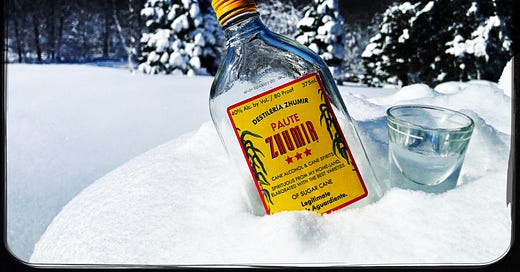Paute Zhumir: Cane Liquor Spirituous From My Home-Land
Tasting a leading brand of Ecuadorian firewater
“Where do we come from? From a century of tradition enriched with history and the magic that has enchanted the people of Ecuador; From Paute, a valley as generous as its people; Zhumir represents a part of the profound identity, is unique as Ecuador.
-Back label, Paute Zhumir
There’s a pint-sized (375 mL) bottle of clear liquor that’s occupied a shelf in our band practice space for years. It has an eye-catching red-and-yellow label with accents of green sugarcane plants. It’s called PAUTE ZHUMIR and as far as I can tell, someone purchased it solely on the merits of 1) It cost $8, and 2) Its label description reads as follows:
CANE ALCOHOL & CANE SPIRITS
SPIRITUOUS FROM MY HOME-LAND
ELABORATED WITH THE BEST VARIETIES
OF SUGAR CANE
But what is this, exactly? It’s distilled from sugarcane juice, as are cachaca and rhum agricole. But these two spirits must each meet very specific criteria to be defined as cachaca or rhum agricole. Paute Zhumir is neither of these spirits.
Instead, Paute Zhumir is an aguardiente, which literally translates to “burning water” or “firewater.” The brand itself is named after the area whence it originates, the valley of Paute, which is located in the province of Azuay in south-central Ecuador. The geography is marked by—surprise!—the Rio Paute and green fields nestled between mountains that open up toward an expansive, azure sky.
A beautiful place to distill firewater.
Aguardiente is not confined to Ecuador, however. It is a popular spirit across Central and South America, with regional and country variations that may include various flavorings. For example, Colombian aguardiente is made with anise, giving it a licorice-like flavor.
Paute Zhumir, on the other hand, is unflavored. It’s crystal clear, and measures a somewhat formidable—but not overwhelming—80 proof. On the nose, there is a slight funky aroma that reminds me of overripe fruit that’s on the verge of going bad. Upon tasting, this brings a pleasing warmth but no real heat. The overwhelming taste here is sweet, with not as much funk as I expected. Despite being unflavored, I still get a bit of licorice and maybe a hint of molasses on the finish. It’s good!
With these characteristics, what should we do with this? It seems a shame not to use this in some sort of local cocktail. Maybe, as we move into the final phase of winter here in the Midwest U.S., a cocktail served hot? The traditional option is the Canelazo, a warm, sweet, citrusy concoction perfect for, I assume, a cool Ecuadorian night.
But I’ll be straight with you: I’m travelling while writing this issue, and didn’t have time or resources (i.e., a stove) to make this one. Maybe there’s a way to chintz out here and add boiling water to a cup filled with sugar, spices and aguardiente, let it steep, and then strain the liquid into another cup and drink that. An experiment for next fall.
Let’s say, like me at the moment, the Canelazo isn’t for you. Maybe you live somewhere the weather is actually warm in March. Or maybe you’re reading this in July. Or just don’t have 30 minutes to simmer a cocktail. The properties of Paute Zhumir mean this spirit lends itself to boozy yet refreshing cocktails served on ice, as well.
You could probably substitute this for light rum in many cocktails, but I want to try this as a split-base together with rum in a refreshing classic: the Daiquiri.
Firewater Daiquiri
0.75 oz rich (2 parts white sugar: 1 part water) simple syrup
0.75 oz fresh squeezed lime juice
1 oz golden rum (I used Appleton Estate 8 Year)
1 oz Paute Zhumir aguardiente
Add ingredients to a cocktail shaker. Add ice. Shake it hard - the drink should be frothy when you pour it. Strain into a coupe or a Nick and Nora glass. Enjoy.
This Paute Zhumir subtly changes the flavor here, but it’s a nice riff on the classic Daiquiri recipe, and stretches your bottle of far pricier rum by splitting it with the inexpensive aguardiente.
Paute Zhumir was surprising. This liquor has earned a spot in my bar rotation, and I look forward to experimenting with it in various tropical and Tiki drinks. For $8, I expected the worst, but was glad to be enchanted by this uncomplicated, pleasant spirit.




